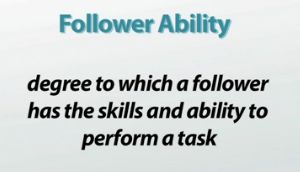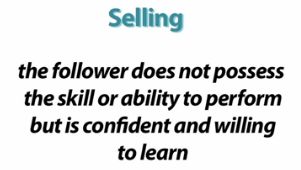Hersey-Blanchard's Model of Situational Leadership - Quiz
Choose your answer and write the correct one down. Then click HERE for the answers to this quiz.
NOTE: The transcript from the video is listed below the quiz for your reference.
1. Follower ability means
- the degree to which the follower possesses skills to perform a task
- the degree to which a follower must perform a task
- the degree to which the follower enjoys doing a task
- the degree to which the boss believed the follower can do a task
- the degree to which the task is easy to do
2. Follower confidence is
- the degree to which a follower wants to perform a task
- the degree to which a follower feels comfortable performing a task
- the degree to which a follower has the skills to perform a task
- the degree to which a follower has the authority to complete a task
- the degree to which the follower actually perform a task
3. Which of the following is NOT part of the leadership style matrix:
- delegating
- participating
- selling
- telling
- controlling
4. If Juan is able to but unwilling to perform a task, he would be best suited with which type of leadership style?
- selling
- participative
- telling
- delegating
- conditional
5. Tara is ready, willing and able to perform a task. She would be best led by:
- selling
- participative
- telling
- delegating
- conditional
6. Juan never worked as a waiter before. He asked his boss to let him take a few tables. He said he was ready to take on the challenge. What type of leadership style would work best?
- selling
- participative
- telling
- delegating
- conditional
7. Tara is a very good hairdresser. She was asked to style the mayor's hair today. She refused to do it because she was afraid she may make a mistake. Which leadership style would work best with Tara?
- participating
- selling
- telling
- delegating
- controlling
8. It's Darla's first day at her very first job at the ice cream parlor. Darla does not know anything about how an ice cream parlor is run. Darla needs:
- controlling
- selling
- telling
- participating
Hersey-Blanchard's Model of Situational Leadership assumes that follower maturity is a major indicator of an employee's readiness to perform work. There are four leadership styles associated with the model: delegating, participating, selling and telling.
Situational Leadership and Follower Maturity
Hersey-Blanchard's situational leadership contends that leaders must adjust their leadership style according to the maturity of their 'followers' or employees. The maturity of the employee directly influences their readiness to work.
 |
Mr. Cash, sales director at Conglom Financial, looks at two factors to determine the maturity level of his followers (or employees): follower ability and follower confidence.
Follower ability is the degree to which a follower has the skills and ability to perform a task. A follower who possesses experience at a particular skill will need less instruction than one who has little experience. Interns with little experience in the financial world would need far more instruction than a seasoned salesperson. When an employee does not possess the skills to perform a task, he will need plenty of direction.
 |
The Leadership Style Matrix
Leaders must be able to change their leadership style to deal with different employees possessing various skill levels. The right leadership style for each employee or group of employees is decided by using a matrix. The matrix is divided into four sections representing four possible leadership styles: delegating, participating, selling and telling.
 |
At Conglom Financial, Mr. Cash uses a delegating style for his most senior salespeople. These employees have been with the company for many years. They worked on major sales projects and wrote many insurance policies over the years. They are given client names and phone numbers and left to do their job without any further direction or supervision.
Participating is necessary when the follower is able but unwilling to perform a particular task. The unwillingness is generally due to low confidence in his or her ability to perform. The leader must participate by sharing ideas with the follower. There is need to build a relationship because although the follower shows a medium level of maturity and the ability to perform, he or she needs the extra coaching from the leader. This is defined as low-task, high-relationship style.
 |
Selling is necessary when the follower does not possess the skill or ability to perform but is confident and willing to learn. The leader must explain the task and any decisions regarding how to perform the task to this follower. Although the follower demonstrates medium maturity, there is a need to focus on tasks and build a relationship with the follower. The leader must persuade this follower to take direction. A persuasive leader can sell the decisions to the follower. Training and follow-up are necessary. This is defined on the matrix as high-task, high-relationship style.
 |
Telling is necessary when the follower does not possess either the ability or the confidence to perform a particular task. Because of this follower's low maturity, the leader must provide explicit direction and close supervision at all times.
Sometimes Mr. Cash takes on high school students as interns, and they are just not as eager and need more than persuading. They also lack work experience. They arrive at Conglom with no experience and no confidence. This is a bit trickier for Cash because he has to direct their every move. So, he tells them exactly what to do and monitors their progress at every step.
 |
Lesson Summary
Hersey-Blanchard's Model of Situational Leadership states that leaders should adjust their leadership style based on the maturity of their followers.
There are two factors used to determine the maturity level of followers. Follower ability is the degree to which a follower possesses the skills and ability to perform a particular task, and follower confidence is the degree to which a follower believes in his or her ability to perform a particular task.
Leaders can use any one of four different leadership styles, depending on the follower's maturity level.
A leader can use a delegating style with followers who possess the skills, ability and confidence to perform the task. This is a low-task, low-relationship style.
A leader can use a participative style with followers who possess the skills and ability but lack the confidence to perform the task. This is a low-task, high-relationship style.
When a follower does not possess the skill or ability but has a high level of confidence, the leader can take a more persuasive leadership approach - selling. The leader may use convincing language to explain how to perform the task. This is a high-task, high-relationship style.
Finally, a follower who has little skills and ability and lacks confidence would benefit from a telling style. The leader must provide clear direction and supervision at all times.